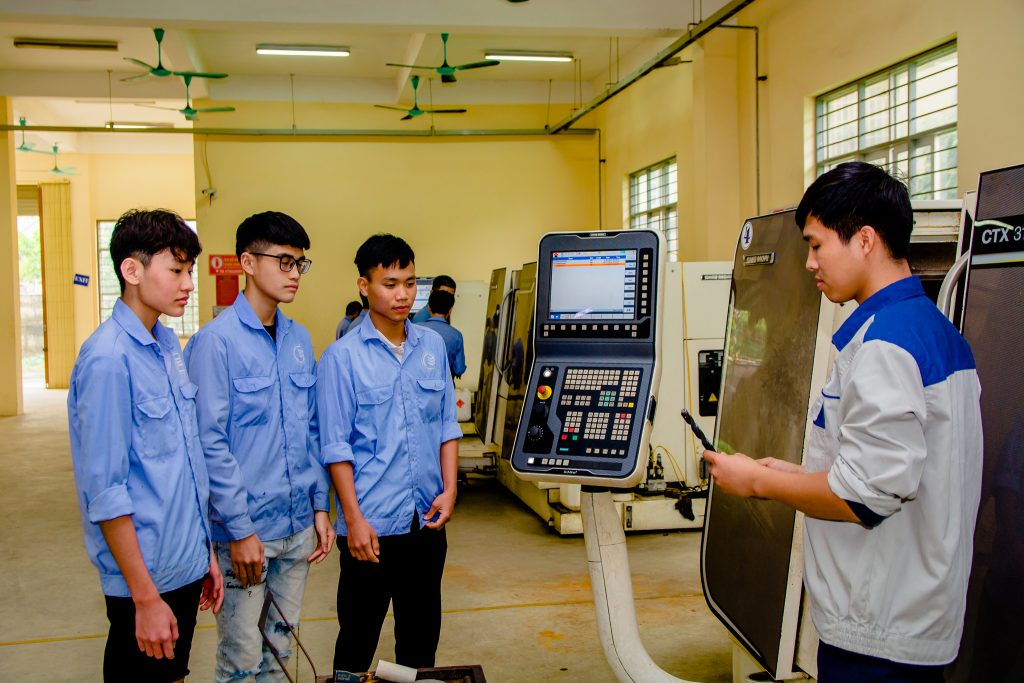Industry overview
- Metal cutting is a mechanical processing process that creates mechanical parts and products with the shape and size of surface gloss … according to technical requirements from the original workpiece by cutting layers. metal in the form of chips. This work can be done by hand or by machine. This is a profession that is commonly trained in vocational schools. After completing this profession, learners will be able to perform skills such as Turning, Milling, Planing, Grinding, Drilling, Stripping, programming and machining on lathe – CNC milling to process details and products.</li >
- The profession of metal cutting Hai Duong Vocational College, is proud to be approved by the Minister of Labor, War Invalids and Social Affairs as an international key profession, invested with 100% new and synchronous equipment. and modern ODA projects; Made in Japan, Korea, Germany (Universal lathe, vertical milling machine, tooth roller milling machine, plane grinding machine, inner round grinding, outer round grinding, centerless grinding, striping machine, reaming machine; CNC-DMG lathe, 3-axis, 5-axis CNC milling center – DMG, GE wire-cutting machine, electric pulse molding machine, 3-D scanning measuring system, rapid prototyping machine, ..vv) Team enthusiastic, passionate lecturers with high professional qualifications, 100% meeting national vocational skills standards
Training target
-
- Analysis of machined detail drawings and assembly drawings;
- Describe the mechanical and physical properties of common materials used in mechanical engineering and heat treatment methods;
- Explain the mounting tolerance system according to TCVN 2244 – 2245;
- Analysis of machining accuracy and method of achieving machining accuracy;
- Explain the structure, working principle, method of measuring, reading, adjusting and preserving the necessary measuring instruments of the profession;
- Describe the operating principles and uses of three-phase asynchronous electric motors, methods of using some simple electric tools used in metal cutting machines;
- Preparing principles and procedures for the production process;
- Analysis of the process of operating, manipulating, maintaining and industrial cleaning of cutting and processing machines of the industry;
- Present cutting and processing methods according to each technology, types of defects, causes and remedies;
- Analysis of the operation and adjustment process when machining on numerically controlled machine tools (CNC milling);
Explain the meaning, responsibilities and rights of employees for occupational accident prevention, industrial hygiene, fire prevention and first aid in order to avoid causing harm to children. people and for production and measures to reduce labor intensity and increase productivity;
- Ability to continue to study further.
- Can draw machining details and assembly drawings;
- Implement measures for occupational safety and industrial hygiene;
- Flexible use of equipment, hand tools;
- Proficiently using common and popular measuring tools of the profession;
- Proficiently using machine tools to process common and basic machine parts with accuracy from level 8 to level 10, roughness from Rz20 to Ra5, meeting technical requirements, correct specified time, ensuring absolute safety for people and machines;
- Operating and adjusting machines for processing complex technologies (when being instructed by senior workers or technicians in workshops or factories) with accuracy from level 9 to level 11, roughness from Rz20 to Ra5, meeting technical requirements, on time, ensuring absolute safety for people and machines;
- Detect and repair common machine, jigs and workpiece failures;
- Make and sharpen simple cutting tools;
- Operating and adjusting numerically controlled machine tools (CNC milling lathes) to process all kinds of machine parts with precision grade 8 to 10, roughness from Rz20 to Ra5, meeting technical requirements technique, at the scheduled time, ensuring absolute safety for people and machines.
Training content
- Can draw workpiece drawings and assembly drawings; read technical drawings;
- Flexible use of common and popular measuring tools of the profession;
- Flexible use of machine tools (Lathes, Milling machines, Planing machines, Grinding machines, Striping machines,.. ) and hand tools;</li >
- Ability to operate and adjust machines for processing complex technologies with accuracy levels from level 8 to level 10, roughness from -Rz20 to Ra5, satisfactory technical requirements, at the scheduled time, to ensure absolute safety for people and machines;
- Detect and correct common defects of machines, fixtures and workpieces;
- Design and manufacture detailed, simple mechanical equipment;
- Make and sharpen simple cutting tools;
- Setting up a machining program, operating and adjusting numerically controlled machine tools (turning, CNC milling) to process all kinds of machine parts reaching the main level Accuracy from level 7 to level 9, roughness from Rz20 to Ra2.5, meeting technical requirements
- Soft skills and foreign languages: Communication skills, presentations, teamwork skills, skills to handle situations arising in the process of doing work, Professional and communicative English.







